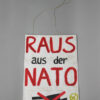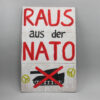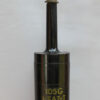“Get out of NATO” demonstration sign
Inventory number: DPM 6.1720
“Defender 2020”, the largest maneuver in Europe for 25 years, was used to exercise the redeployment of US forces to the eastern edge of the NATO alliance and thus to the border with Russia. Previously, only the deployment of brigades had been practiced; the deployment of an entire division was planned to be five times as large, with around 29,000 US soldiers. As the “Host Nation Support”, Germany served as an important partner for this maneuver due to its central location in Western Europe, as it did during the Cold War, and provided support in areas such as logistics, transport and supplies. The costs for the German treasury were to amount to around 2.3 million euros and up to 4,000 Bundeswehr soldiers were to be involved. However, due to the spread of the coronavirus pandemic, far fewer soldiers were involved in the maneuver and joint exercises with the Bundeswehr, e.g. in Munster, were canceled. Originally planned from February to May, the maneuver was ended prematurely in March.
According to the Bundeswehr, this test of military cooperation was intended to “underpin a clear commitment to Europe’s security” on the part of the USA and “the credible implementation of joint alliance obligations” on the part of Germany. In addition to the military feasibility test, the maneuver thus had a clear political thrust: in the tense relationship between the two countries during Trump’s administration, this cooperation was a step towards each other – but also a threatening gesture towards Russia, which for its part had carried out large-scale maneuvers in Belarus and in its own country in recent years and whose annexation of Crimea had made the governments in the Baltic states and Poland feel threatened.
Critics saw the maneuver as a dangerous provocation by Russia and a furthering of the arms race. Peace organizations and parties such as the DKP and DIE LINKE organized protests at the places where troop movements were to take place and responsible politicians were invited. For example, Greenpeace disrupted the landing of US tanks in Bremerhaven with rubber dinghies, while the tankers arrived in Hamburg by plane.
On 28.02.2020, a demonstration took place in Hamburg when NATO Secretary General Jens Stoltenberg and Foreign Minister Heiko Maas were invited to a banquet as guests of honor at Hamburg City Hall. The “Get out of NATO” demonstration sign designed for this event is an appeal to the German government to withdraw from NATO. The crossed-out tank on the demonstration sign refers to the main battle tank as a central and therefore iconic symbol of military armament. The yellow peace signs show the wish that peace would be secured with the demand “Out of NATO”.
NATO (North Atlantic Treaty Organization) is an alliance of 30 North American and European countries, which has both military and civilian organizational parts (such as the North Atlantic Council). In the history of NATO, there have always been countries that have joined the political bodies of the alliance at times but not the military ones, or have withdrawn from them, such as France, Spain and Greece. Left-wing critics see Germany’s withdrawal from NATO’s military structures as necessary to maintain peace. However, a complete withdrawal of Germany from NATO would mean a fundamental restructuring of Europe’s security architecture, which is why a strengthening of diplomatically oriented alliances such as the OSCE is being called for as a counterbalance to the establishment of a system of collective security. Although Germany’s withdrawal from NATO is therefore not impossible, politically it is currently only seen as a realistic option by a left-wing minority.
Object of the month
(short) stories from the depot
Unfortunately, many objects cannot currently be shown in the exhibition for conservation reasons. Here you will find unusual objects and exciting stories of special pieces from the depot
















